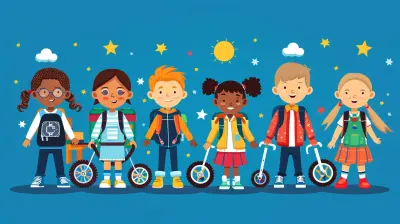The Role of Interactive Media in Enhancing Distance Education
23 May 2025
Education has come a long way from traditional chalk-and-talk methods. Today, a student sitting in a small town can access lectures from Ivy League professors, all thanks to distance education. But let’s be honest—staring at long, monotonous video lectures or reading endless PDFs can make even the most dedicated learner zone out. That’s where interactive media steps in, turning passive learning into an engaging, hands-on experience.
So, how exactly does interactive media enhance distance education? Let’s dive in!

What Is Interactive Media?
Before we get into the impact, let’s break it down. Interactive media refers to digital tools and content that allow users to actively engage instead of just consuming information passively. This includes:- Videos with quizzes
- Virtual reality (VR) and augmented reality (AR)
- Gamified learning experiences
- Simulations and interactive case studies
- Live polls and discussion boards
In a nutshell, interactive media makes learning more engaging, immersive, and effective—which is exactly what distance education needs!

How Does Interactive Media Enhance Distance Learning?
1. Boosts Engagement and Retention
Let’s face it—staring at slides for hours can get boring. Imagine instead clicking through an interactive module, answering questions in real time, and even competing with friends in a learning game. That’s far more exciting and memorable, isn’t it?Studies show that interactive learning improves retention rates significantly compared to passive learning. Why? Because when students are actively involved, their brains make stronger connections with the information. Think of it like learning to ride a bike—watching someone else do it is one thing, but actually hopping on and trying it yourself? That sticks with you.
2. Personalized Learning Experience
Not everyone learns at the same pace. Some students grasp concepts quickly, while others need more time. Interactive media allows for self-paced learning, letting students pause, replay, or dive deeper into topics they find challenging.For example, interactive platforms use AI to adapt the content based on how a student performs. Struggling with a math problem? The system might suggest a simpler explanation or offer extra practice questions. This personalized approach ensures that no learner feels left behind.
3. Encourages Active Participation
Traditional online courses often rely on passive learning—watching videos, reading PDFs, or listening to lectures. But real learning happens when students interact with the material.Interactive elements like drag-and-drop exercises, clickable infographics, or even voice-assisted instructions make learning hands-on and engaging. These elements prevent students from drifting off or multitasking, keeping them focused on the subject matter.
4. Bridges the Gap Between Theory and Practice
One of the biggest challenges in distance learning is the lack of hands-on experience. Interactive media, especially simulations and virtual labs, solve this problem.Take medical students, for example. They can’t learn surgery by just reading books. But with VR simulations, they can practice procedures in a risk-free virtual environment before working on real patients.
The same goes for engineering, chemistry, or even business studies. Want to test your marketing strategies without real-world risk? There’s an interactive business simulation for that! This approach makes learning practical and application-based, rather than just theoretical.
5. Improves Collaboration and Social Learning
One common complaint about online education is that it can feel isolating. Without classmates around, students sometimes miss out on the peer-to-peer interaction that traditional classrooms offer.That’s where discussion boards, live chat forums, and collaborative projects powered by interactive media come into play. Virtual group activities, online debates, or even multiplayer learning games bring students together, fostering a sense of community.
When learners discuss ideas, debate concepts, or solve problems as a team, it enhances their critical thinking and makes learning more enjoyable.
6. Instant Feedback for Continuous Improvement
Remember those days when you had to wait weeks for test results? Interactive media eliminates that frustration!With automated quizzes, real-time assessments, and AI-driven feedback, students get instant insights into their performance. They can immediately see what they got wrong, receive explanations, and even attempt the question again.
This not only boosts confidence but also helps them improve instantly, making the learning process more efficient and effective.

Real-World Examples of Interactive Media in Distance Education
Now that we know why interactive media is a game-changer, let’s look at some real-world applications:- Khan Academy – Uses interactive exercises and instant feedback to help students master math, science, and more.
- Duolingo – Uses gamification to make language learning fun and addictive.
- Coursera & Udemy – Many courses now include interactive quizzes, peer-reviewed assignments, and discussion forums.
- Google Expeditions (VR Learning) – Lets students take virtual field trips around the world without leaving home.
- Labster – Provides virtual labs for science students, allowing them to conduct experiments safely in a digital space.

The Future of Interactive Media in Distance Education
As technology advances, so will interactive media in education. Here’s what we can expect moving forward:- More AI-Powered Personalization – AI will tailor lessons even better based on student performance and learning styles.
- Immersive Learning with AR & VR – Virtual classrooms with real-time interactions are becoming more common.
- Gamification on a Larger Scale – More courses will incorporate elements like leaderboards, badges, and challenges to keep students motivated.
- Integration with Metaverse – The concept of virtual campuses where students can interact, collaborate, and learn in an immersive environment is gaining traction.
Final Thoughts
Distance education doesn’t have to be boring or isolating. Interactive media brings learning to life, making it engaging, practical, and effective. Whether through VR labs, gamified lessons, or AI-driven personalization, it ensures that students don’t just passively absorb information—they actively experience it.As technology continues to evolve, the possibilities for interactive learning are endless. So, if you’re an educator or student, it’s time to embrace the future of learning—because education is no longer just about reading books, it’s about living the experience!
all images in this post were generated using AI tools
Category:
Distance EducationAuthor:

Fiona McFarlin
Discussion
rate this article
3 comments
Korian Lawrence
Great insights! Interactive media truly transforms distance education by making learning more engaging and accessible. It's exciting to see how these tools foster connection and creativity among students. Looking forward to seeing more innovative approaches in the future!
June 16, 2025 at 10:48 AM

Fiona McFarlin
Thank you! I'm glad you found the insights valuable. Exciting times lie ahead as we continue to explore innovative ways to enhance distance education!
Winter Gates
Interactive media significantly enriches distance education by fostering engagement, improving retention, and facilitating collaboration, ultimately creating a dynamic and effective learning environment.
May 28, 2025 at 3:29 AM

Fiona McFarlin
Thank you for your insightful comment! I completely agree that interactive media plays a crucial role in enhancing engagement and collaboration in distance education.
Brick Bennett
Interactive media: bridging gaps in distant learning!
May 23, 2025 at 4:07 AM

Fiona McFarlin
Thank you! Interactive media indeed plays a crucial role in creating engaging and effective learning experiences, making distance education more accessible and effective.



